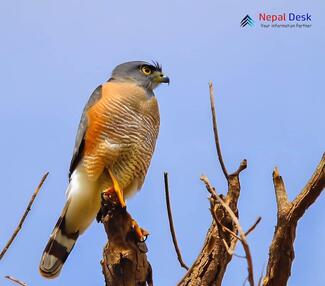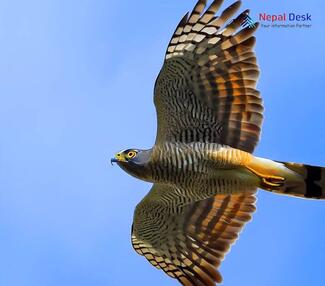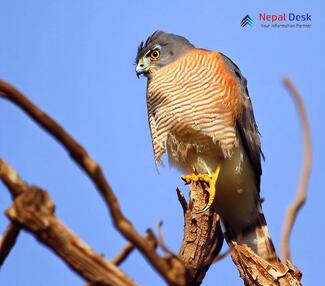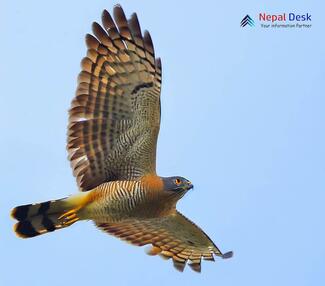Nepal, a country known for its rich biodiversity and stunning landscapes, is home to a wide variety of bird species. Among them is the remarkable Crested Goshawk (Accipiter trivirgatus), a raptor that demonstrates both grace and power. It is related to other diurnal raptors such as eagles, buzzards (or buteos), and harriers, and thus placed in the family Accipitridae. This fascinating bird of prey can be found in the dense forests and subtropical regions of Nepal. In this article, we'll explore the unique characteristics of the Crested Goshawk and what makes it an important part of Nepal's ecosystem.
Appearance and Characteristics
The Crested Goshawk is a medium-sized raptor with a slate-grey plumage on its upper body. The undersides are often marked with horizontal bars of white and dark grey. Adult birds are easily identified by their distinctive white eyebrows and crest, which can be raised during aggressive displays. Its wings are relatively short but broad, well-adapted for maneuverability through dense foliage.
Habitat and Distribution
The Crested Goshawk thrives primarily in dense subtropical and tropical forests throughout Asia, from the Indian subcontinent all the way to Indonesia. In Nepal specifically, these birds can be spotted in regions like Bardia National Park, Shivapuri Nagarjun National Park, and Chitwan National Park. They favor areas abundant in tall trees to build their nests and have ample cover to hunt for their prey.
Diet and Hunting Behavior
Crested Goshawks mainly feed on small mammals such as rodents or squirrels as well as birds like pigeons or parrots. They may even occasionally prey upon small reptiles such as lizards or snakes. These agile hunters use ambush tactics to catch their prey by surprise. They often perch silently within tree branches waiting for the opportune moment to swoop down on their target.
Breeding and Nesting
The breeding season for Crested Goshawks in Nepal generally takes place between March and June. During this time, the males will perform impressive aerial displays to attract a mate. Once a pair is formed, they work together to construct their nest high up in tall trees. The female will lay a clutch of 2-4 eggs which she incubates for around 35 days. Both parents contribute to raising their offspring, taking turns feeding the chicks with small mammals and birds until they are ready to fledge.
Conservation Status
The Crested Goshawk population in Nepal is currently categorised as "Least Concern" on the IUCN Red List. However, habitat loss due to deforestation and agricultural expansion remains a constant threat to this species. Efforts should be made to protect their natural habitats by implementing sustainable development practices and promoting awareness about the importance of biodiversity within local communities.
In conclusion, the Crested Goshawk is an intriguing bird of prey that plays an essential role in the ecosystem of Nepal. By preserving their habitats and raising awareness about these remarkable creatures, we can ensure that future generations will have the opportunity to marvel at their beauty and grace as they soar through Nepal's forests.




